The Stone Circles of Cumbria
by Dr. Gareth Evans
Once part of the ancient kingdom of Rheged -- the southern province of a realm of Brithonic Celts which stretched from the English Lake District to the river Clyde in Scotland -- the modern county of Cumbria lies on England's north western border. Uther Pendragon, father of the legendary Arthur, is said to have ruled here in the 5th Century, and few areas of Cumbria lack some association, however tenuous, with Arthurian legend.
However, while the wind-blasted fells appear to have held particular spiritual importance for these post-Roman Celts, the stone monuments that dot the bleak landscape are of far older origins, with a long history of probable ritual or religious use.
Some good examples of these are to be found within a few miles of the main M6 motorway, mainly around Penrith, while the rest of these remarkable Neolithic or Bronze Age sites lie just a short detour away from Windermere and the Lake District's other attractions.
Sites of the M6 Corridor
Casterton Stone Circle
Travelling north up the M6, the first site lies about six miles east of the motorway, just over the Lancashire/Cumbria county border. Casterton stone circle consists of 19 stones -- all under two feet high -- forming a circle some 62 feet in diameter, set in an irregular earthwork mound. It dates from the late Neolithic or early Bronze Age (2000-600 BC). Although not the most imposing physical site, it has proved one of the most fruitful for artefacts, with over 1,800 finds recorded, including drinking vessels, flint arrowheads and a bronze spearhead.
Long Meg and her Daughters
This remarkable Bronze Age site is the third largest stone circle in England and dates from around 2000-900 BC. It comprises over 60 stones arranged in a rough circle measuring 357 feet by 305 feet, while the eponymous Long Meg herself -- a 12-foot red sandstone monolith decorated with circles, spirals and ring designs -- stands a little way outside, aligned to the setting of the mid-winter sun.
Predictably, myths and legends have grown up about the site. Long Meg herself is said to bleed if chipped, but probably the best known story surrounding this site is that the "daughters" were originally a coven of witches, caught dancing at their sabbat celebrations and turned to stone by the 13th Century Scottish wizard Michael Scot. In common with a number of other circles, it is said that no one counting the stones can come up with the same number twice; in this case it is probably best not even to try, for the local legend has it that should anyone succeed, the spell will be broken and the witches freed.
 Nor, it seems, are any of the coven keen to leave their sisters, and dire consequences are promised if anyone tries to remove a stone from its place -- a part of the story which does seem to have at least some basis in fact. In the early 18th Century, the owner of the local Manor decided to use some of the group as milestones, but the idea was abandoned when, from out of a clear sky, wild storms descended upon the workmen, forcing them to flee in fear of their lives.
Nor, it seems, are any of the coven keen to leave their sisters, and dire consequences are promised if anyone tries to remove a stone from its place -- a part of the story which does seem to have at least some basis in fact. In the early 18th Century, the owner of the local Manor decided to use some of the group as milestones, but the idea was abandoned when, from out of a clear sky, wild storms descended upon the workmen, forcing them to flee in fear of their lives.
William Wordsworth visited Long Meg, and a poem about the site appears in his series "Composed or Suggested During a Tour in the Summer of 1833" (see below). Some sources suggest that he claimed to have known about the monument as a very young child, while others say that he chanced upon it unexpectedly during the course of a walk. He says in his own notes that he came across it by surprise, but given the inaccuracy of his other comments regarding the "perfect" nature of the circle and the size of Long Meg, it is hard to be certain.
(For more information on Long Meg and Castlerigg, see Castlerigg, Long Meg and Her Daughters.)
Little Meg
Half a mile from Long Meg is Little Meg, a circle 20 feet in diameter. The circle encloses a prehistoric burial site and comprises 11 stones, the tallest of which stands around 3.5 feet high. Some of the stones bear cup and ring markings similar to those on Long Meg, but it has been suggested that these may not be contemporary with the Bronze Age origins of either site, possibly being later additions in both cases. Little Meg stands on private land and can be viewed from the minor road that passes the field.
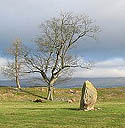 Mayburgh Henge
Mayburgh Henge
Located at the confluence of the rivers Eamont and Lowther, the Mayburgh Henge site covers about 1.5 acres of land, its circular earthworks approaching 300 feet in diameter and rising to 14 feet in height. Today, only one single stone, some nine feet tall, remains standing at its centre, the sole surviving upright of the original inner circle, its fellows having been either destroyed by artillery practice in the 18th Century or hauled away for use as building materials in the 19th.
Moor Divock
Moor Divock contains a group of prehistoric sites consisting of a number of cairns, megaliths and stone circles, though many of the stones have fallen or been removed. Some of this windswept and scattered collection have been named, such as "The Cockpit" -- a 90-foot circle -- and "White Raise", a cairn found to have contained human bones. The various sites are located on the southwestern edge of the Lakeland Fells, near the village of Askham. Access to Askham Fell is by foot and the walk requires care, although experienced walkers will enjoy some of the wildest and most magnificent views in England.
Lake District Sites
Castlerigg
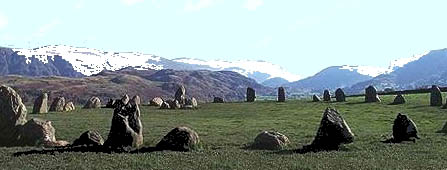 Moving on from Penrith along the A66 towards Keswick and Derwent Water, the first of the Lakeland sites encountered is Castlerigg, which dates from around 3200 BC, making it one of the first stone circles to be constructed in England and amongst the earliest in all Britain. Covering over a quarter of an acre of land, the 38 stones (five of which have fallen from their upright position) are arranged in a slightly flattened oval some 90 feet in diameter and represent one of the best prehistoric sites in Cumbria. It is said that there were 422 stones originally, but the fate of the missing megaliths has never been established, despite considerable conjecture on the subject.
Moving on from Penrith along the A66 towards Keswick and Derwent Water, the first of the Lakeland sites encountered is Castlerigg, which dates from around 3200 BC, making it one of the first stone circles to be constructed in England and amongst the earliest in all Britain. Covering over a quarter of an acre of land, the 38 stones (five of which have fallen from their upright position) are arranged in a slightly flattened oval some 90 feet in diameter and represent one of the best prehistoric sites in Cumbria. It is said that there were 422 stones originally, but the fate of the missing megaliths has never been established, despite considerable conjecture on the subject.
The purpose of the site has proved another area of speculation over the years, though there seems to be broad agreement that the alignment of the stones indicate an astronomical function. This has led some to suggest that the site might have been an ancient temple, while others have proposed that it was a place for tribal meetings, or an early trading centre -- intriguing ideas, but in the absence of hard evidence, unverifiable at least for now.
The poet John Keats visited Castlerigg in 1818, as part of his major walking tour of Britain, later immortalising it -- though erroneously associating it with the Druids -- in the opening sections of Book II of Hyperion, his ambitious allegorical story of ancient gods. Viewed in its natural amphitheatre, surrounded by the bleak hillsides and reached without the convenience or ease of modern roads, the site was bound to make a powerful impression on this major figure of the English Romantic movement. In this light, his description of the "...dismal cirque/Of Druid stones, upon a forlorn moor..." is entirely understandable and should be forgiven its historical inaccuracies.
In a final twist to the site's 5.25 millennia of history, aerial lights have been reported hovering above the stones -- a fitting irony perhaps that one of Britain's oldest sites should today be associated with UFOs.
Elva Plain Stone Circle
Ten miles or so further west along the A66 from Castlerigg lies the Elva Plain Stone Circle, on the south side of Elva Hill. The almost perfect circle is around 125 feet in diameter, but only half of the original 30 stones remain today, none projecting more than three feet above ground. Elva Hill itself is locally known as a fairy hill and it has been suggested that the name may have Norse origins, referring to the home of elves, though this is uncertain. The circle is almost certainly Late Neolithic and is widely believed to have been associated with the local trade in stone axes, which were manufactured at sites in the central fells and taken via Borrowdale over the hills to the east.
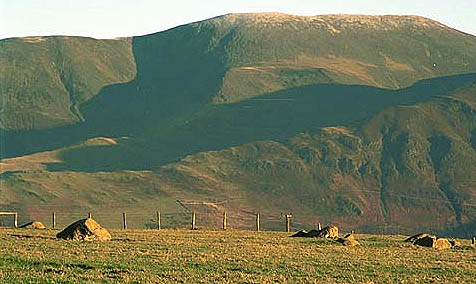 The site today is not particularly impressive, but it remains a worthwhile minor detour for the interested visitor. It sits on private farmland but can be approached via a footpath from the adjoining minor road.
The site today is not particularly impressive, but it remains a worthwhile minor detour for the interested visitor. It sits on private farmland but can be approached via a footpath from the adjoining minor road.
Grey Croft Stone Circle
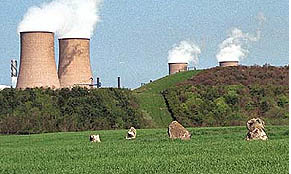 Located within a few hundred yards of British Nuclear Fuel's Sellafield complex and thus literally juxtaposed between the Neolithic and nuclear ages, the Grey Croft Circle has retained ten of its original twelve stones in a ring approaching 100 feet in diameter. A lone outlying block stands some 35 yards away. The site, which dates from around 2500 BC, has yielded a number interesting artefacts, including an early Bronze Age lignite ring found within a burial cairn.
Located within a few hundred yards of British Nuclear Fuel's Sellafield complex and thus literally juxtaposed between the Neolithic and nuclear ages, the Grey Croft Circle has retained ten of its original twelve stones in a ring approaching 100 feet in diameter. A lone outlying block stands some 35 yards away. The site, which dates from around 2500 BC, has yielded a number interesting artefacts, including an early Bronze Age lignite ring found within a burial cairn.
All but one of the stones were deliberately buried in the early 19th century by the land's tenant farmer in an effort to speed up his ploughing, and remained hidden until 1949, when a certain W. Fletcher and boys from Pelham House School rediscovered them. The stones were subsequently replaced in their original positions.
This is another site located on private property, but it can be viewed from a adjacent public footpath.
Swinside Stone Circle
Swinside is possibly the best stone circle in Cumbria and is widely held to be one of the finest examples of its kind in the whole of Britain. Originally there were 60 stones in the 90-foot ring, and today all but five still remain, though only 32 are standing. The tallest of these approaches eight feet in height and weighs an estimated five tons. The portal stones at the southern face of the site appear to be aligned with the midwinter sun when viewed from the circle's centre -- where a long-missing marker stone once stood -- suggesting that, like many others, this circle possibly performed some astronomical role.
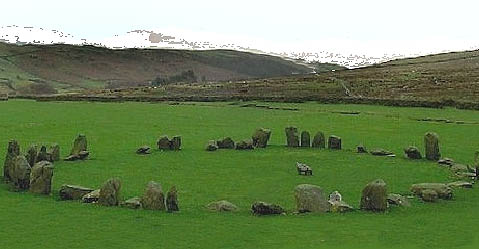 Like many of its fellows, Swinside has its legends -- one, again, being that the stones are uncountable. This is something of a recurring theme where prehistoric circles are concerned! One story, however, is unique to Swinside and concerns its alternative name: Sunkenkirk, meaning buried church. According to the legend, it had once been chosen as the building site for a new church, but each night the devil destroyed the day's construction, burying the broken rubble under the soil. This continued night after night until the builders were eventually forced to give up and the church was finally erected elsewhere.
Like many of its fellows, Swinside has its legends -- one, again, being that the stones are uncountable. This is something of a recurring theme where prehistoric circles are concerned! One story, however, is unique to Swinside and concerns its alternative name: Sunkenkirk, meaning buried church. According to the legend, it had once been chosen as the building site for a new church, but each night the devil destroyed the day's construction, burying the broken rubble under the soil. This continued night after night until the builders were eventually forced to give up and the church was finally erected elsewhere.
Other Sites
There are, of course, many more sites in Cumbria, ranging from large monuments to much smaller burial rings. The county is home to something in the region of 50 stone circles of varying types, with some of the oldest examples in Britain being included in that number. The visitor is never very far away from one! Castlerigg, Long Meg and Swinside are clearly sites of major importance, but even the smallest or least impressive of their brethren have something to offer those seeking insight into the early history of Britain's past.
Locations
Casterton Stone Circle: The circle is located to the northeast of the village of Casterton, which is itself about one mile north of Kirkby Lonsdale. From the south, leave the M6 at junction 34 (just north of Lancaster) and follow the A683 through Kirkby Lonsdale to Casterton. From the north, leave the M6 at junction 36 and take the A65; once in Kirkby Lonsdale, turn left on to the A683 for Casterton.
Long Meg and her Daughters: This site lies near to the village of Little Salkeld, about seven miles to the north east of Penrith. From junction 40 of the M6, briefly take the A66 towards Brough, turning onto the A686 (Alston) road after about a mile. Follow this for a further four miles to Langwathby and then take the minor road to Little Salkeld. The approach to the site itself is well signposted.
Little Meg: This circle stands towards the edge of a field, beside the minor road from Little Salkeld to Glassonby. The site itself is on privately owned land.
Mayburgh Henge: Sited very close to Penrith, beside the B5230, close to its junction with the A6 at Eamont Bridge.
Moor Divock: At the southwest edge of the fells near Askham and Helton off the minor road south of Penrith. Access is by foot and cannot really be recommended to inexperienced fell walkers. Although good walking maps exist, there are many boggy areas on the surrounding moors and great care must be taken. Local tour guides are sometimes available.
Castlerigg: The circle is located south of the A66, near its junction with the A591, about a mile east of Keswick. The site is well signposted and access is easy, which can lead to it being very busy in peak season.
Elva Plain Stone Circle: The site lies on the southern slopes of Elva Hill, nearly four miles east of the town of Cockermouth, on land owned by Elva Farm. The land is private, but access is made over a public footpath from the minor road.
Grey Croft Stone Circle: The site is to the north of Seascale (off the main A595 coast road) close to the BNFL Sellafield Visitor Centre and stands on private land which forms part of the Seascale How Farm. It can be approached by the public footpath which crosses Seascale Golf Course.
Swinside Stone Circle: Situated approximately five miles north of the town of Millom, to the west of Broughton-in-Furness along a minor road off the A595. A short walk is required to view the site but as one of the finest circles in Cumbria, and arguably in all of the British Isles, Swinside is certainly worth the effort.
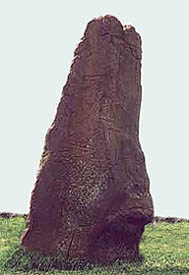 |
The Monument Commonly Called
Long Meg and Her Daughters,
Near the River Eden
by William Wordsworth
A weight of awe, not easy to be borne,
Fell suddenly upon my Spirit -- cast
From the dread bosom of the unknown past,
When first I saw that family forlorn.
Speak Thou, whose massy strength and stature scorn
The power of years -- pre-eminent, and placed
Apart, to overlook the circle vast --
Speak, Giant-mother! tell it to the Morn
While she dispels the cumbrous shades of Night;
Let the Moon hear, emerging from a cloud;
At whose behest uprose on British ground
That Sisterhood, in hieroglyphic round
Forth-shadowing, some have deemed, the infinite
The inviolable God, that tames the proud!
|
Related Articles:
- Castlerigg, Long Meg and Her Daughters, by Lisa Agnew
- https://www.timetravel-britain.com/articles/stones/meg.shtml
- The Fairy Hills of Cumbria, by Dr. Gareth Evans
- https://www.timetravel-britain.com/articles/stones/fairy.shtml
More Information:
We regret that we no longer have the resources to maintain up-to-date links and/or hours and pricing details for the various sites and attractions listed on this website. For more information about the location(s) listed above, please use your favorite search engine or visit Wikipedia.
Gareth Evans is a freelance writer and photographer, having previously worked in the private sector before lecturing at the University of Durham. Having travelled extensively, he now concentrates on writing about subjects much closer to home -- both geographically and metaphorically. He is particularly interested in myths, legends and folklore, together with the often forgotten history of the Celtic lands, especially that of his own native Wales and Scotland, his adopted home. Gareth is currently planning his next book, looking at the role of the pagan Horned God in myth and history.
Article © 2005 Gareth Evans
Long Meg, Long Meg's Daughters, Castlerigg and Swinside © Gareth Evans
Mayburgh Henge, Elva Plain and Grey Croft Courtesy of VisitCumbria.com
|
